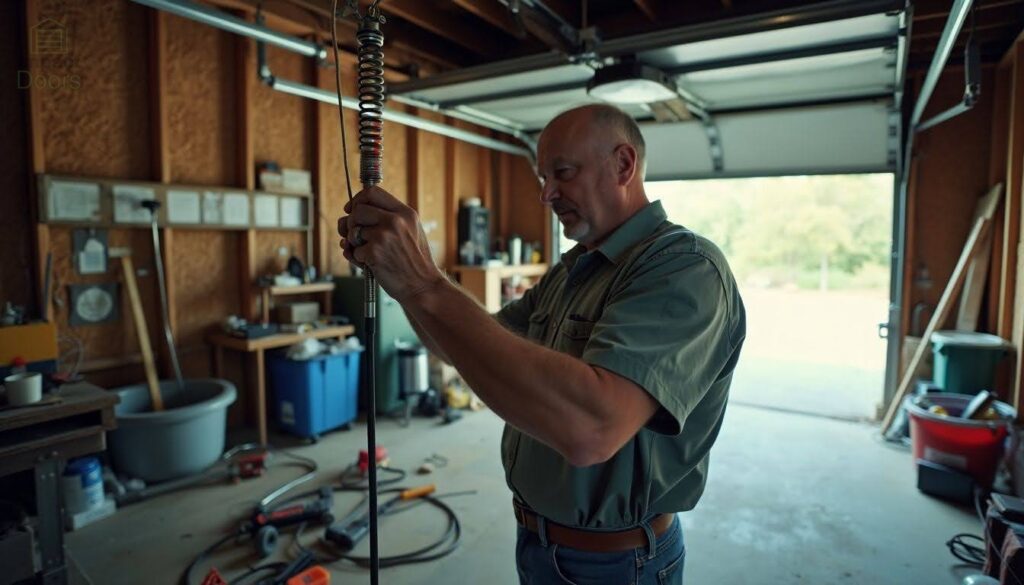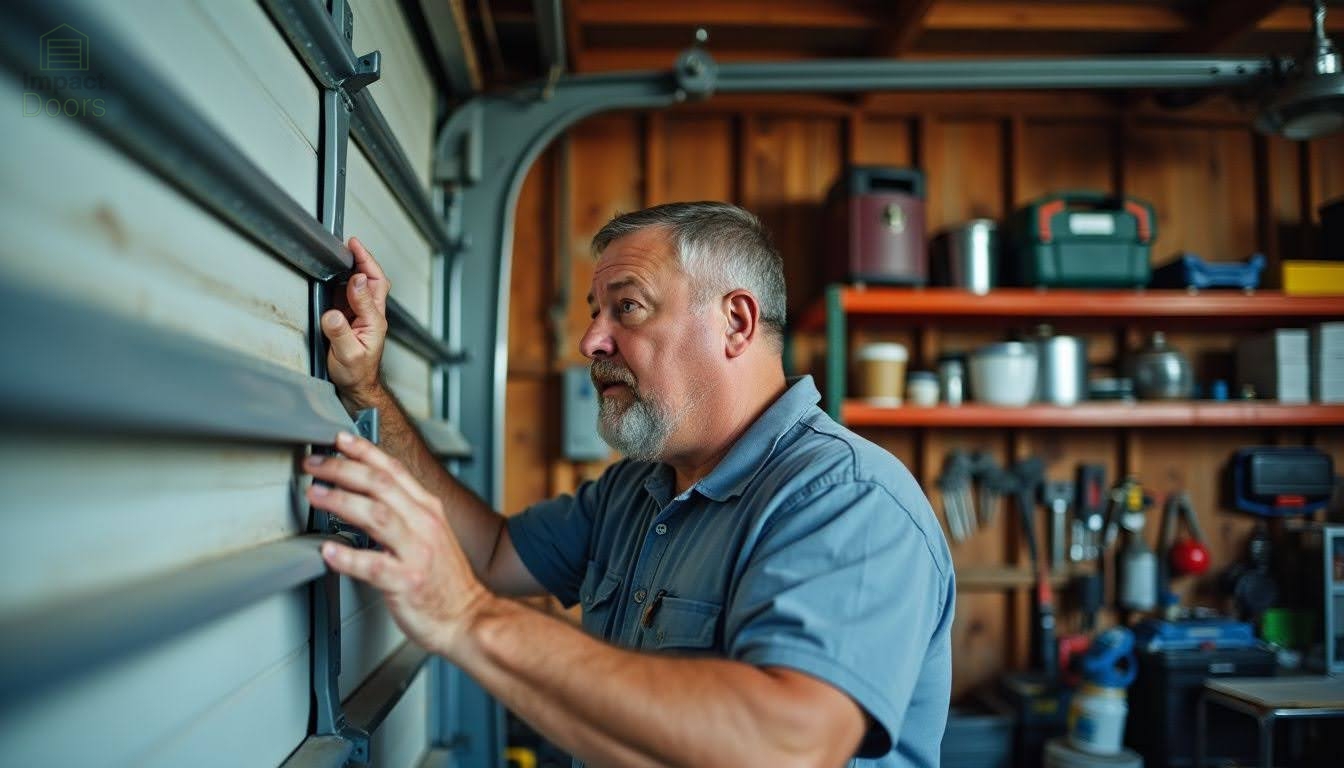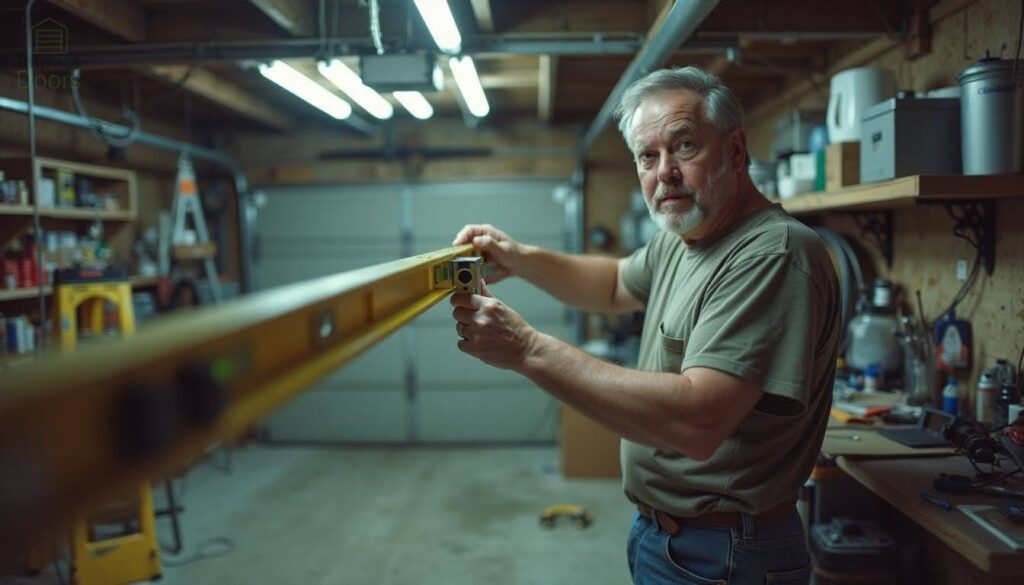Is your beauty new door making strange noises or moving slowly? You’re not alone. Many homeowners face garage door issues due to lack of upkeep. Garage doors open and close about 1,500 times a year on average.
This blog post will teach you simple garage door preventive maintenance tips to keep your door running smoothly. Ready to save money and avoid headaches?
Key Takeaways
- Regular cleaning and inspection of garage door tracks prevent debris buildup and ensure smooth operation.
- Lubricating moving parts like rollers, hinges, and springs twice a year reduces wear and tear, extending the door’s lifespan.
- Testing the auto-reverse feature and photoelectric sensors at least twice annually is crucial for safety, especially for homes with children and pets.
- Performing a balance test by manually lifting the door halfway can reveal issues with springs and cables before they become major problems.
- Changing remote batteries every 6-12 months and checking opener functionality regularly helps maintain convenient and reliable garage door operation.
Essential Maintenance Tips
Keep your garage door in top shape with these key tips. Regular upkeep can save you money and headaches down the road.
Inspect and Clean the Tracks
Garage door tracks collect dirt and grime over time. Clean tracks help your door move smoothly and prevent wear. Here’s how to inspect and clean your garage door tracks:
- Look for debris in the tracks. Use a flashlight to spot leaves, pebbles, or spider webs.
- Wipe tracks with a damp cloth. This removes loose dirt and dust buildup.
- Scrub stubborn grime with a soft brush. Don’t use harsh chemicals that might damage the metal.
- Check for dents or bends in the tracks. Small issues can cause big problems later.
- Tighten any loose bolts or screws. Use a socket wrench to secure hardware.
- Apply a thin coat of lubricant. This helps the rollers glide smoothly.
- Test the door’s movement. It should open and close without sticking or making noise.
- Remove rust spots with fine-grit sandpaper. Paint over bare metal to prevent future rust.
- Clear the area around the tracks. Keep tools and stored items away from the door’s path.
- Repeat this process every few months. Regular cleaning extends your door’s life.
Lubricate Moving Parts Regularly
Keeping your garage door parts slick is key to smooth operation. Regular lubrication cuts down on wear and tear, making your door last longer.
- Pick the right lube: Use a garage-door-specific lubricant. It works best on metal parts and won’t gum up like other oils.
- Hit the rollers: Grease steel rollers twice a year. Skip this step for nylon rollers – they don’t need it.
- Don’t forget the hinges: A little dab on each hinge keeps things quiet and rust-free.
- Tackle the springs: A light coat on the torsion spring helps it coil and uncoil smoothly.
- Lube the chain or belt: If you have a chain-drive opener, keep it oiled. For belt-drives, a silicone-based spray works wonders.
- Clean first, then lube: Wipe down parts before adding lubricant. This stops dirt from getting trapped in the grease.
- Less is more: Don’t go overboard. Too much lube attracts dust and grime.
- Stay safe: Always unplug the opener before you start. Safety first!
Next up, let’s talk about tightening all that hardware. It’s another simple step to keep your garage door in top shape.
Tighten All Hardware
Loose hardware can cause your garage door to wobble and wear out faster. Regular tightening keeps your door running smoothly and safely.
- Grab a socket wrench and screwdriver. These tools will help you tighten most nuts and bolts on your garage door.
- Start at the top of the door. Work your way down, checking each bracket and hinge for loose screws or bolts.
- Tighten any loose hardware you find. Don’t overdo it – just snug them up enough to stop any movement.
- Skip the red-painted hardware. These parts need to move freely, so leave them alone.
- Avoid the bottom roller bracket. This part is under high tension and can be dangerous to adjust.
- Listen for rattles as you open and close the door. Any noise could point to spots you missed.
- Repeat this process every few months. With 3-4 daily uses, garage doors need frequent checks.
- Call a pro if you’re not sure. Some parts can be tricky or risky to adjust on your own.
Check and Replace Weatherstripping
Weatherstripping plays a key role in your garage door’s health. It blocks water and outdoor stuff from sneaking into your garage. Over time, this rubber seal can get brittle or crack.
When that happens, it’s time for a swap. Fresh weatherstripping boosts your garage’s energy smarts too.
A good seal keeps the elements out and comfort in.
Don’t ignore those little gaps around your door. They can lead to big problems. Next up, let’s talk about some crucial safety checks for your garage door.

Safety Checks
Safety checks keep your garage door from becoming a hazard. They’re quick and easy to do. Want to learn how to protect your family and property? Keep reading!
Test the Auto-Reverse Feature
Auto-reverse is a crucial safety feature for garage doors. It stops and reverses the door if it hits something while closing. To test it, place a 2×4 board flat on the ground under the door.
Close the door using the opener. The door should touch the board and then reverse direction. If it doesn’t, you need to adjust the door or call a pro. This simple test can prevent injuries and damage.
Don’t skip this important check. Do it at least twice a year. It only takes a few minutes but can save lives. Kids and pets often play near garage doors. A working auto-reverse keeps them safe from accidents.
If your door fails the test, stop using it right away. Call a trusted service like Impact Doors for help. They can fix the problem fast and keep your family safe.
Evaluate the Photoelectric SystemPhotoelectric sensors play a key role in garage door safety. These small devices sit near the bottom of your door tracks. They send an invisible beam across the door opening. If something breaks this beam while the door closes, it stops and reverses.
To test them, wave a broom under a closing door. The door should stop and go back up right away.
Make sure your sensors line up correctly. Misaligned sensors can cause your door to act up. Clean the lenses with a soft cloth to keep them working well. If your door won’t close or keeps reversing for no reason, check these sensors first.
A pro can help if you can’t fix the problem yourself.
A well-maintained photoelectric system is your garage door’s guardian angel.
Perform a Balance Test
A balance test keeps your garage door safe and smooth. To do it, close the door and unplug the opener. Then, lift the door halfway by hand. A well-balanced door will stay put. If it drops or shoots up, you’ve got a problem.
Don’t try to fix it yourself. Call a pro right away. They’ll adjust the springs and get your door back in shape.
This test is crucial for your door’s health. It spots issues before they become big headaches. A balanced door puts less strain on the opener, saving you money in the long run. Plus, it cuts down on noise and makes your door last longer.
So, check your door’s balance every few months. It’s a simple task that pays off big time.

Checking Key Components
Your garage door has some key parts that need regular checks. Cables, springs, and openers all play vital roles in keeping your door running smoothly.
Examine Cables and Springs
Cables and springs are vital parts of your garage door system. They need regular checks to keep your door working safely and smoothly.
- Look at the cables: Check for any frays or tears. Don’t try to fix damaged cables yourself. They can be very dangerous.
- Check spring tension: Open the door halfway. It should stay in place. If it doesn’t, the springs might need adjusting.
- Listen for noises: Unusual sounds when the door moves could mean spring issues. Pay attention to squeaks or grinding noises.
- Inspect for rust: Rust on springs can weaken them over time. Clean off any rust you see with a wire brush.
- Look for gaps: Gaps in the coils of torsion springs can show they’re wearing out. Call a pro if you spot this problem.
- Check for balance: Close the door and pull the release handle. Lift the door manually. It should move easily and stay open when you let go.
- Examine for wear: Look at where cables wrap around pulleys. Fraying in these spots needs quick attention from a garage door expert.
Ensure Opener Functionality
Garage door openers are the unsung heroes of our daily lives. They lift heavy doors with ease, but they need our attention too. Check your opener’s performance often. Listen for odd noises or watch for slow responses.
These signs might indicate potential issues. Don’t ignore them.
Test your opener’s force settings regularly. This step keeps you safe from accidents. Also, clean the photo eye sensors monthly. Dust can block their signal and cause issues. If problems arise, explore the repair options available in Brisbane to address the issue promptly.
Call a pro right away. Quick action saves money and prevents future complications.
A stitch in time saves nine, especially regarding garage door openers.
Replace Remote Batteries
Remote batteries play a key role in your garage door’s smooth operation. Swapping them out regularly keeps your door working like a charm.
- Check battery type: Look at your remote’s manual or the old batteries to find the right kind.
- Open the remote: Slide off the cover or use a small screwdriver to pop it open.
- Remove old batteries: Take out the old ones, noting how they fit.
- Clean contacts: Wipe the metal contacts with a dry cloth to remove any gunk.
- Insert new batteries: Put in fresh ones, matching the plus and minus signs.
- Test the remote: Press the button to make sure it works before closing the cover.
- Set a reminder: Mark your calendar to change batteries every 6-12 months.
- Dispose properly: Recycle old batteries at a local drop-off point.
- Keep spares handy: Stock up on extras to avoid being stuck with a dead remote.
- Consider rechargeable: Think about switching to rechargeable batteries for less waste.
Conclusion
Garage door upkeep doesn’t have to be a chore. With these simple tips, you can keep your door running smoothly for years. Regular checks and quick fixes can save you from costly repairs down the road. Lubricating the moving parts and inspecting the door’s balance every few months can go a long way in ensuring its durability. Additionally, cleaning the tracks and checking for worn-out components will help prevent unexpected malfunctions. Understanding the importance of garage door upkeep not only enhances functionality but also increases the safety and security of your home.
Don’t forget to test safety features and lubricate moving parts often. If you’re ever unsure, call a pro – it’s better to be safe than sorry with such a large moving object in your home.
Garage Door Repair Near You
Facing garage door problems? Rely on Jarred and the skilled team at Impact Doors for fast, professional repairs. With a dedication to quality, we’ll have your garage door opener working flawlessly in no time. Contact us at (07) 5451 4022 for dependable service today!


